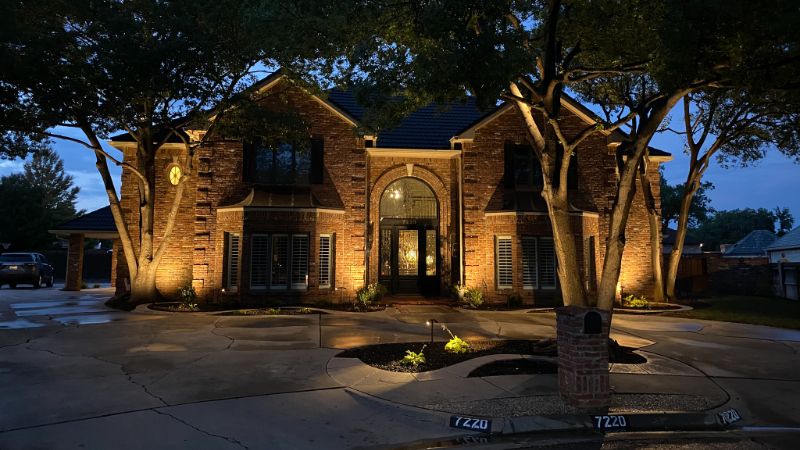What Does an Outdoor Lighting Professional Consider When Designing an Outdoor Lighting System?
Designing an outdoor lighting system is both an art and a science. It requires a deep understanding of lighting principles, a keen eye for aesthetics, and a thorough consideration of the property’s unique characteristics. At Holt Outdoor Lighting, we take a comprehensive approach to designing outdoor lighting systems, ensuring that each project is tailored to meet the specific needs and preferences of our clients. In this article, we’ll explore the various factors that an outdoor lighting professional considers when designing a lighting system, from the size and layout of the property to the client’s budget.
The Size and Layout of the Property
Assessing the Overall Scope
The first step in designing an outdoor lighting system is to assess the size and layout of the property. This includes understanding the overall dimensions, the positioning of key features, and how different areas of the property are connected. A large estate with sprawling gardens and multiple outdoor spaces will require a more extensive lighting system than a smaller, more compact property.
Key Considerations for Property Size and Layout
- Coverage: How much of the property needs to be illuminated? A larger property may require more fixtures and a carefully planned layout to ensure even coverage.
- Zones: The property may be divided into different zones, each with its own lighting needs. For example, a front yard may require a different lighting approach than a backyard or garden area.
- Pathways and Connections: How do guests and residents move through the property? Understanding the flow of movement helps in placing pathway lighting, ensuring safe and easy navigation from one area to another.
Tailoring the Design to Fit the Property
An outdoor lighting professional will tailor the design to fit the specific characteristics of the property. For example, a property with natural slopes, hills, or uneven terrain may require specialized lighting to highlight these features while ensuring safety. Similarly, a property with a large open lawn may benefit from wide-angle lighting to cover more ground, while a densely landscaped garden may require more focused lighting to accentuate specific plants or features.
The Size, Shape, and Style of the Home
Architectural Features and Home Style
The architecture of the home plays a significant role in determining the lighting design. The size, shape, and style of the home, including its architectural features, are all critical factors that influence the choice and placement of lighting fixtures.
Highlighting Architectural Features
- Columns and Pillars: These can be accentuated with uplighting to create dramatic shadows and emphasize the height and grandeur of the home.
- Rooflines and Eaves: Lighting along the rooflines or eaves can outline the shape of the home, making it stand out against the night sky.
- Windows and Doors: Strategic lighting around windows and doors not only highlights these features but also enhances security by illuminating entry points.
Complementing the Home’s Style
The style of the home—whether it’s modern, traditional, rustic, or something else—will influence the type of lighting fixtures chosen. A modern home might benefit from sleek, minimalist fixtures, while a more traditional home may look best with classic lantern-style lights. The goal is to choose lighting that complements the home’s architectural style, enhancing its overall appearance without overpowering it.
The Surrounding Grounds: Gardens, Landscapes, and Water Features
Enhancing Gardens and Landscape Beds
The surrounding grounds of the property, including gardens, landscape beds, and other greenery, are key areas for outdoor lighting. A well-designed lighting system can highlight the beauty of these natural features, creating a stunning nighttime landscape.
Key Considerations for Garden and Landscape Lighting
- Plant Height and Density: Taller plants and trees may require uplighting to illuminate their full height, while lower-growing shrubs and flowers may be best highlighted with ground-level lights.
- Flower Beds and Borders: These areas can be accentuated with low-voltage lights that provide a soft glow, drawing attention to the vibrant colors and textures of the plants.
- Seasonal Changes: An outdoor lighting professional will consider how the landscape changes with the seasons, ensuring that the lighting design remains effective year-round.
Illuminating Trees and Shrubs
Trees and shrubs are often focal points in outdoor lighting designs. The type of tree (deciduous, evergreen, flowering, etc.) and its placement on the property will determine the best lighting approach. Uplighting is commonly used to create dramatic effects by casting shadows and highlighting the texture of the bark and leaves.
Showcasing Water Features
Water features like ponds, fountains, and waterfalls add a unique element to any property, and lighting can enhance their visual appeal. An outdoor lighting professional will consider the movement of the water, the surrounding landscape, and the desired effect—whether it’s a tranquil, reflective atmosphere or a lively, dynamic display.
Considerations for Water Feature Lighting
- Submersible Lights: These can be placed inside the water feature to create an ethereal glow that illuminates the water from within.
- Surrounding Landscape: Lighting the area around the water feature, such as rocks, plants, or pathways, enhances the overall effect and ensures safety.
- Reflection and Movement: The play of light on moving water can create captivating reflections and patterns, adding a dynamic element to the design.
Pathways, Driveways, and Entrances
Ensuring Safe Navigation with Pathway Lighting
Pathway lighting is essential for ensuring that guests can safely navigate the property after dark. Whether it’s guiding visitors from the parking area to the front door or lighting up garden paths and walkways, pathway lighting is both functional and aesthetically pleasing.
Key Considerations for Pathway Lighting
- Even Spacing: Lights should be evenly spaced to provide consistent illumination along the path.
- Directional Lighting: Pathway lights should be angled to guide the way without causing glare or shining directly into the eyes of those walking.
- Aesthetic Integration: The design of the pathway lights should complement the surrounding landscape and the overall style of the property.
Illuminating Driveways and Entrances
Driveways and entrances are critical areas for outdoor lighting, as they are often the first things guests see when approaching the property. Proper lighting in these areas not only enhances curb appeal but also improves safety and security.
Driveway Lighting
- Marker Lights: These can be used along the edges of the driveway to guide vehicles safely and prevent them from veering off the path.
- Entrance Pillars or Gates: Uplighting or spotlighting these features creates a grand entrance, making the property more inviting.
Entrance Lighting
- Front Door Illumination: Lights around the front door should be bright enough to ensure visibility and safety but also styled to match the home’s aesthetic.
- Security Considerations: Motion-sensor lights or dusk-to-dawn fixtures can be used at entrances to enhance security by illuminating the area whenever someone approaches.
Patios, Backyards, Pools, and Hot Tub Areas
Creating a Relaxing Ambiance with Patio Lighting
Patios and backyard spaces are often used for relaxation and entertainment, and the right lighting can enhance the atmosphere, making these areas more enjoyable after dark.
Key Considerations for Patio Lighting
- Ambient Lighting: Soft, warm lighting is ideal for creating a cozy, inviting atmosphere on the patio.
- Task Lighting: If the patio includes a grilling or dining area, task lighting ensures that these spaces are well-lit for practical use.
- Accent Lighting: Highlighting architectural features or surrounding landscape elements adds depth and interest to the patio area.
Highlighting Pool and Hot Tub Areas
Pools and hot tubs are often the centerpiece of a backyard, and effective lighting is essential for both safety and aesthetics.
Pool Lighting
- Underwater Lights: Submersible lights can be installed within the pool to create a glowing, inviting appearance.
- Surrounding Deck Lighting: Lights around the pool deck ensure safe movement and can be used to highlight the area’s design elements.
Hot Tub Lighting
- Soft, Ambient Lighting: Soft lighting around the hot tub creates a relaxing atmosphere, perfect for unwinding after a long day.
- Privacy Considerations: Lighting should be placed to enhance the ambiance while maintaining privacy for those using the hot tub.
The Client’s Budget
Designing Within Budget Constraints
One of the most important considerations for any outdoor lighting project is the client’s budget. At Holt Outdoor Lighting, we believe in designing lighting systems that are both beautiful and affordable. We work closely with clients to understand their budget constraints and provide solutions that meet their needs without compromising on quality or aesthetics.
Budget-Friendly Solutions
- Phased Installation: For clients with limited budgets, we can implement the lighting system in phases, focusing on key areas first and expanding the system over time.
- Energy Efficiency: Choosing energy-efficient LED lights can reduce long-term operating costs, making the initial investment more affordable in the long run.
- Custom Design: We tailor the design to fit the client’s budget, selecting fixtures and materials that provide the best value without sacrificing style or functionality.
The Art of Outdoor Lighting Design
Designing an outdoor lighting system requires a careful balance of technical knowledge, artistic vision, and practical considerations. By taking into account the size and layout of the property, the architectural style of the home, the surrounding landscape, and the client’s budget, an outdoor lighting professional can create a system that enhances the beauty, safety, and usability of any outdoor space.
At Holt Outdoor Lighting, we pride ourselves on our ability to deliver customized lighting solutions that meet the unique needs of each client. Whether you’re looking to illuminate a small garden or a sprawling estate, our team has the expertise to bring your vision to life. Contact us today to learn more about our outdoor lighting services and how we can help you create the perfect lighting system for your property.
If you would you like to schedule an outdoor lighting consultation for your property please give us a call (806) 777-4949 or fill out our online contact form and someone will be getting back to you shortly to schedule your appointment.

